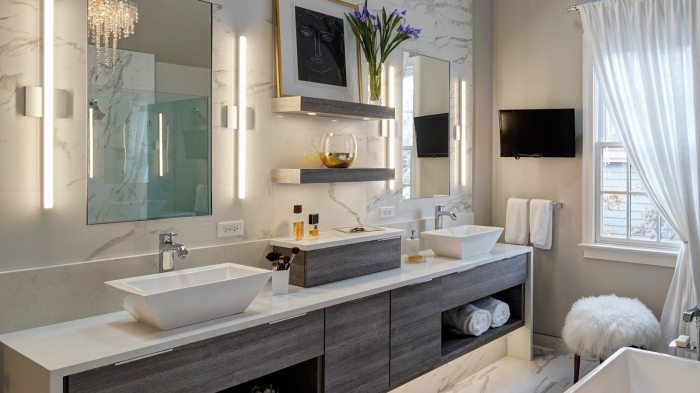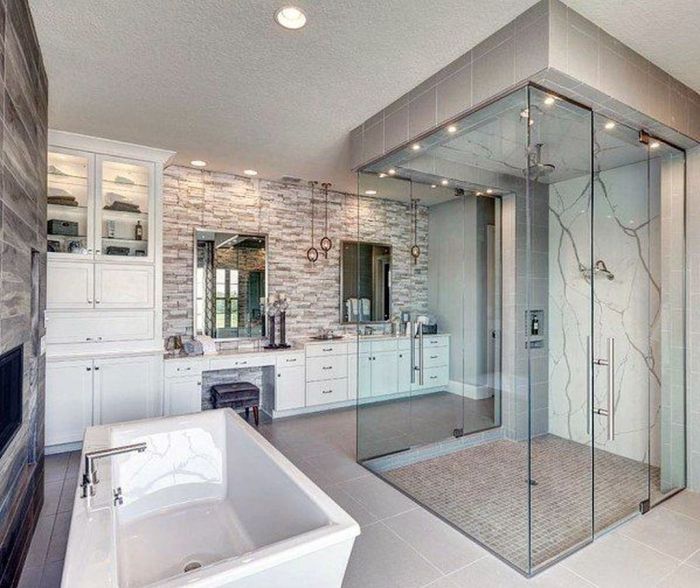Luxury Master Bathroom Design Trends

Master bathroom decor ideas – Let’s face it, the bathroom isn’t just a place to, ahem,attend to business* anymore. It’s your personal spa, your sanctuary, your throne room of tranquility. And if you’re going for luxury, you’re aiming for a level of pampering that would make Cleopatra jealous. So, let’s dive into some seriously decadent bathroom design trends.
Freestanding Soaking Tubs and Multi-Head Showers: A Symphony of Relaxation
Imagine this: you’re sinking into a glorious freestanding soaking tub, the kind that looks like it belongs in a five-star hotel (because, let’s be honest, it should). The tub itself is crafted from luxurious materials – perhaps a smooth, warm marble, or a sleek, modern cast iron. Above, a rainfall shower head cascades water onto you, while smaller shower heads strategically placed along the wall offer a customizable massage experience.
Forget about a simple shower; this is a full-body hydrotherapy session, complete with built-in chromatherapy for a truly immersive experience. High-end fixtures, such as polished chrome or brushed nickel faucets, add a touch of refined elegance, while underfloor heating keeps your toes toasty even on the chilliest mornings. This isn’t just a bathroom; it’s a wellness retreat.
Modern Farmhouse Master Bathroom Mood Board: Rustic Charm Meets Modern Sophistication
Picture this: The walls are painted a calming shade of creamy white, reminiscent of fresh milk, offset by warm, honey-toned oak flooring. The vanity is a repurposed antique dresser, carefully restored and fitted with modern, minimalist faucets. A large, ornate mirror hangs above, reflecting the natural light streaming in from a window draped with linen curtains. A few strategically placed potted succulents add a touch of greenery, while a chunky, woven rug adds texture and warmth underfoot.
The overall feel is one of relaxed elegance, a perfect blend of rustic charm and modern sophistication. Think Joanna Gaines, but with a slightly more luxurious twist. This isn’t your grandma’s farmhouse bathroom; this is farmhouse 2.0.
Maximizing Natural Light and Ventilation for a Spa-Like Atmosphere
Natural light is the secret weapon in creating a truly spa-like bathroom. Large windows, skylights, and even strategically placed mirrors can help to maximize the amount of natural light that floods the space. This not only makes the room feel brighter and more spacious but also creates a sense of calm and serenity. Adequate ventilation is equally important, preventing the buildup of moisture and ensuring a fresh, clean air.
Think about incorporating exhaust fans, open windows (weather permitting, of course!), and perhaps even a small, stylish window in the shower enclosure. A well-ventilated bathroom feels cleaner, fresher, and more inviting.
High-End Bathroom Vanities: Showstoppers in Style and Functionality
High-end bathroom vanities are more than just places to store your toiletries; they’re statement pieces. A sleek, minimalist vanity made of lacquered wood can add a touch of modern sophistication, while a grand, ornate vanity crafted from reclaimed wood can bring a touch of vintage charm. Consider a floating vanity for a space-saving and modern look, or a double vanity for a luxurious touch of shared convenience.
The possibilities are endless, and the choice depends entirely on your personal style and the overall design of your bathroom. Remember, the vanity is often the focal point of the room, so choose wisely!
Small Master Bathroom Space Optimization

Let’s face it, not all of us are blessed with master bathrooms the size of a small apartment. But fear not, tiny bathroom dwellers! With a little clever planning and a dash of design ingenuity, you can transform your cramped quarters into a luxurious and functional oasis. We’re talking about maximizing space without sacrificing style – because even a postage-stamp-sized bathroom deserves to be fabulous.
Small bathrooms present a unique design challenge, demanding creative solutions to accommodate all the necessities without feeling claustrophobic. The key is to think vertically, utilize every inch, and employ visual tricks to expand the perceived space. Think of it as a design puzzle – and we’re here to provide you with the pieces.
Maximizing Storage in a Small Master Bathroom, Master bathroom decor ideas
Storage is the holy grail of small bathroom design. Forget those flimsy over-the-toilet organizers that look like they’re about to collapse under the weight of a single roll of toilet paper. We’re talking about serious, space-saving solutions. Built-in shelving, cleverly tucked away above the toilet or under the sink, is a game-changer. Imagine sleek, floating shelves showcasing your favorite bath products, or deep drawers concealing your less aesthetically pleasing necessities (we all have them!).
Custom cabinetry, tailored to your exact needs and space, can provide a surprisingly large amount of storage in a surprisingly small footprint. Think vertical drawers, pull-out organizers, and even mirrored cabinet doors to double the visual impact.
Creating the Illusion of Space
Mirrors, mirrors on the wall, who’s the fairest bathroom of them all? Well, it’s yours, once you’ve strategically placed a large mirror (or several smaller ones). Mirrors not only reflect light, making the space feel brighter and more open, but they also visually double the size of the room. Think a large mirror above the sink, or even a full-length mirror on the back of the door.
Combine this with light, airy colors – think pale blues, greens, or whites – to enhance the sense of spaciousness. Avoid dark colors, which can make a small room feel even smaller. Clever design techniques, such as using glass shower doors instead of opaque ones, also help to maximize the feeling of openness.
Compact Bathroom Fixtures and Accessories
Choosing the right fixtures and accessories is crucial for maximizing space in a small bathroom. Forget oversized tubs and bulky vanities – we’re going for sleek, streamlined designs that are both functional and visually appealing. A wall-mounted sink, for instance, frees up valuable floor space. Consider a corner sink to maximize the use of awkward spaces. Compact toilets, which are surprisingly efficient, can also save a surprising amount of room.
Small, but stylish, accessories, such as floating shelves, slim towel racks, and space-saving dispensers, will keep your small bathroom clutter-free and aesthetically pleasing. Imagine a beautiful, minimalist design with everything having its place – a small space can be a wonderfully calming and efficient space.
Space-Saving Shower/Tub Combination
The age-old debate: shower or tub? In a small bathroom, the answer is often “both,” but cleverly combined. A shower/tub combination allows you to enjoy the best of both worlds without sacrificing precious square footage. Look for compact designs with efficient showerheads and strategically placed shelving. A corner shower/tub unit, for example, is a smart way to make use of an often-underutilized space.
Think of it as a multi-functional marvel, combining relaxation and practicality in one streamlined package.
Master Bathroom Color Palettes and Schemes: Master Bathroom Decor Ideas

Choosing the right color palette for your master bathroom is like choosing the perfect soundtrack for your spa day – it sets the mood and can make or break the whole experience. Get it wrong, and you’ll end up with a bathroom that feels more like a prison cell than a sanctuary. Get it right, and you’ll have a space where you can truly unwind and de-stress.
Let’s dive into some options that will have you saying “ahhhhh.”
Calming Color Palettes
A calming master bathroom should evoke feelings of serenity and tranquility. Think spa-like retreats, not chaotic mornings. We’ll achieve this using soft, muted tones that promote relaxation. One excellent option is a palette based around soft blues and greens, reminiscent of a tranquil seaside escape. Imagine walls painted in a soft “Sea Salt” (a light, airy blue-grey), complemented by pale green accents in the shower tiles or vanity.
Natural materials like light oak wood for the vanity and woven seagrass rugs would further enhance this serene atmosphere. Adding touches of white or off-white keeps the space bright and airy, preventing it from feeling too dark or claustrophobic.
Vibrant Color Palettes
For those who prefer a more energetic and exciting space, a vibrant palette is the way to go. This doesn’t mean neon everything! Instead, we’ll focus on bold, saturated colors used strategically to create a sense of invigorating luxury. A deep teal or emerald green can make a statement as the primary wall color. Pair this with gold accents – think gold-toned faucets, lighting fixtures, or even decorative elements.
Introduce pops of coral or bright orange through towels or artwork to add further vibrancy without overwhelming the space. The key is balance; a vibrant palette needs careful consideration to avoid feeling too chaotic.
Neutral Color Palettes
Neutral palettes are the chameleons of the design world – incredibly versatile and adaptable. They create a timeless, sophisticated look that’s easy to update with accessories. A classic choice is a palette centered around various shades of grey, from light greige to charcoal. This provides a chic, modern backdrop. Introduce warmth with natural wood tones in the flooring or vanity, and add texture through marble countertops or a patterned rug.
Adding pops of color through plants or artwork can easily personalize the space without disrupting the overall neutral scheme. Think of it as a blank canvas that you can easily decorate and redecorate as your mood changes.
Warm vs. Cool Color Palettes: A Comparison
Warm color palettes (think reds, oranges, yellows) generally create a feeling of warmth, coziness, and even intimacy. They can make a small bathroom feel more welcoming and inviting, but too much warmth can feel overwhelming or even cramped. Cool color palettes (blues, greens, purples) are associated with calmness, spaciousness, and serenity. They can make a small bathroom feel larger and more airy, but an overuse of cool tones can create a sterile or cold atmosphere.
The key is finding the right balance – a warm accent color in a cool-toned bathroom, for example, can create a perfect harmony.
Color’s Effect on Perceived Size and Mood
Light, airy colors like whites, pastels, and light blues visually expand a space, making a small bathroom feel larger. Darker colors, while adding drama and sophistication, can make a room feel smaller and more enclosed. Similarly, the mood is significantly impacted. Cool colors promote relaxation and tranquility, while warm colors energize and invigorate. A small, poorly lit bathroom painted in dark colors will feel cramped and gloomy, whereas the same bathroom painted in light, bright colors will feel significantly larger and more cheerful.
Think of it like this: a sunny yellow kitchen always feels more spacious than a dark, moody one, even if they are the same size.
Bathroom Paint Finish Comparison
Choosing the right paint finish is crucial for durability and aesthetic appeal in a high-moisture environment like a bathroom. Here’s a quick guide:
| Paint Finish | Durability | Cleanability | Suitability |
|---|---|---|---|
| Matte | Low | Low | Accent walls, areas with less moisture |
| Satin | Medium | Medium | Walls, ceilings |
| Semi-gloss | High | High | Trim, doors, shower surrounds (with proper sealant) |
| Gloss | Very High | Very High | Cabinetry, trim in high-moisture areas |
Essential Questionnaire
What are some eco-friendly options for master bathroom decor?
Consider sustainable materials like bamboo, reclaimed wood, and recycled glass. Look for low-VOC paints and water-efficient fixtures.
How can I incorporate smart technology into my master bathroom?
Smart toilets, heated floors, voice-activated lighting, and digital shower controls offer convenience and luxury.
What’s the best way to choose a vanity for my master bathroom?
Consider your available space, storage needs, and desired style. Think about the countertop material and sink type too.
How important is ventilation in a master bathroom?
Proper ventilation is crucial to prevent mold and mildew growth and to eliminate excess moisture.

